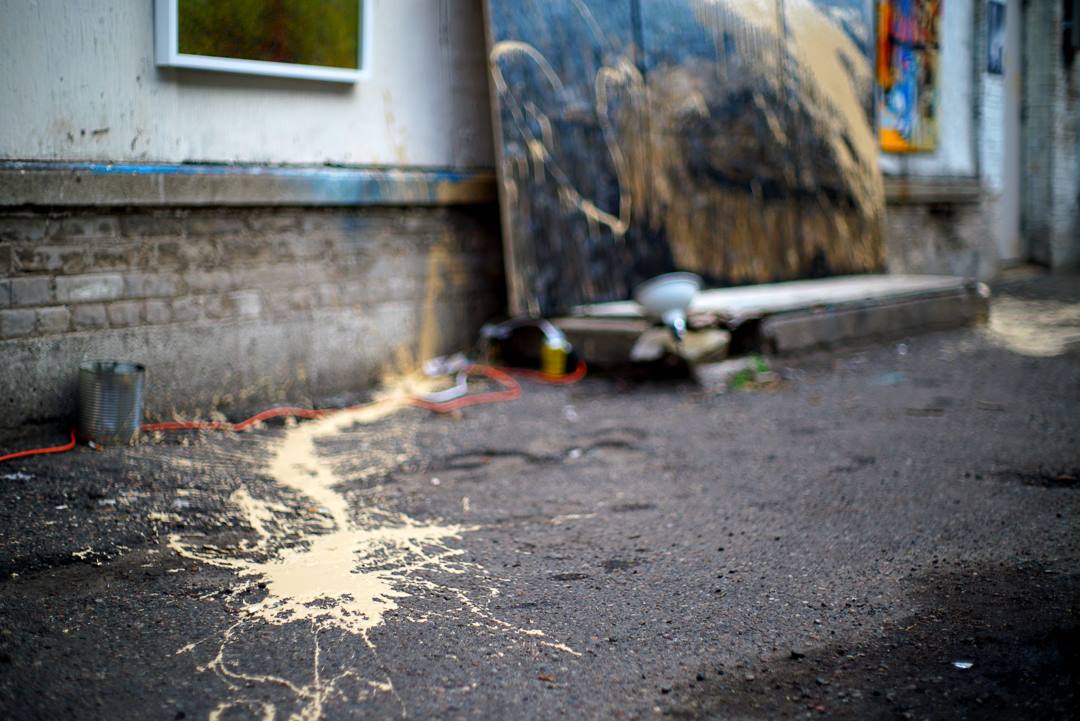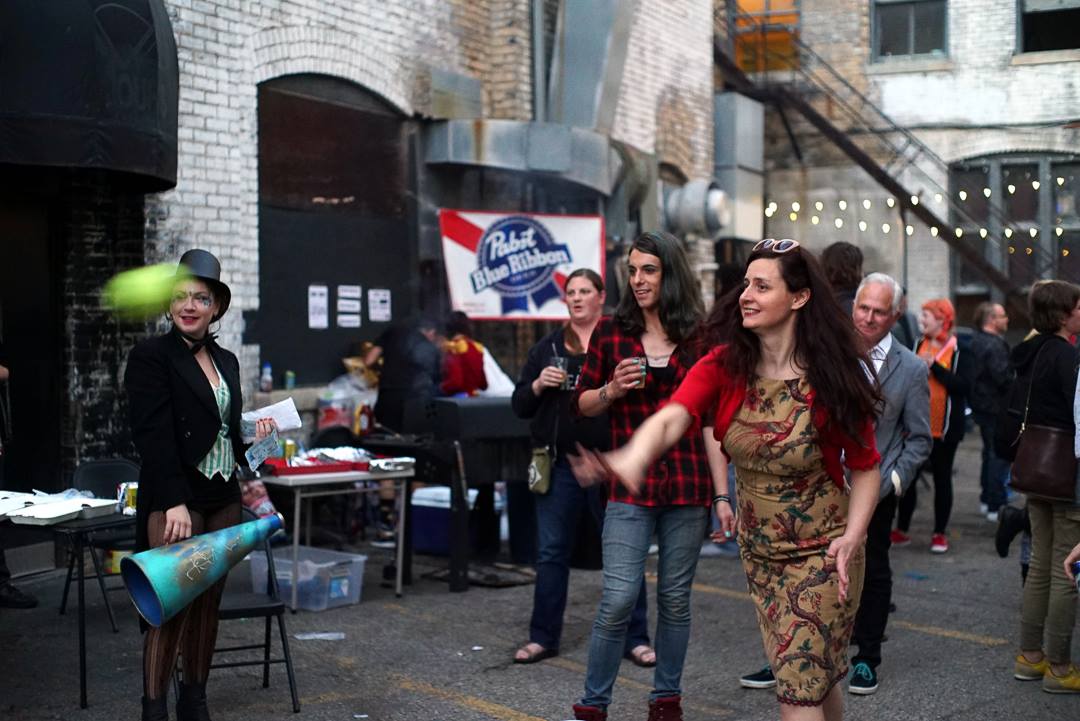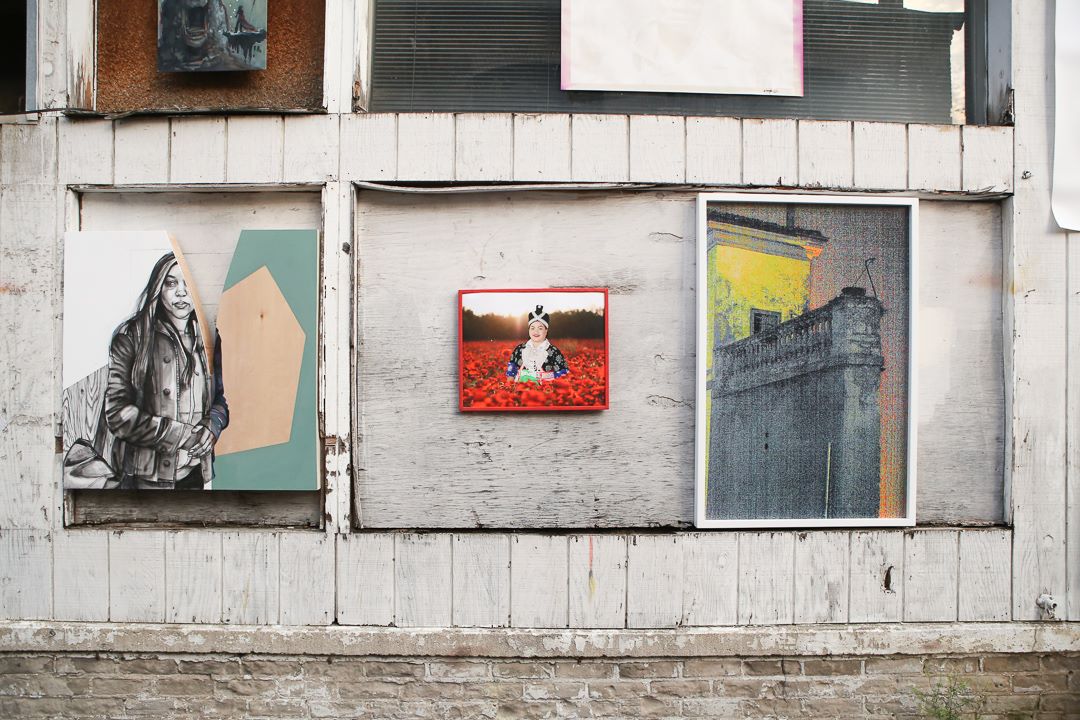One Night in the Alleyway Institute
Rob Callahan reports back from Gamut Gallery's ephemeral, back alley art collaboration-cum-"carnival of urban bohemia" that served as the swan song of their old space in downtown Minneapolis.

Art is hard. That’s not because it’s physically hard on you, like construction work or meth is. Art is hard like religion is hard. Everyone has a sui generis religious experience – one that’s unique, personalized even. There is no universally shared experience by which to define it. So, everyone at church knows exactly what it means to be religious, but no one agrees on what that is: The experience is exactly, but not quite, entirely unlike everyone else’s experience.
So it is with art, too. No one can really say what makes an artwork objectively good or bad, but everyone tries. That very vagueness and unattainability are what keep artists striving for betterment and art critics in work. Some may argue the measure of good art is the number of patrons it can attract. Others say, forget about patrons, and look instead at how daring or thought-provoking the work is. The first group could then counter that no one is provoked if the art fails to draw a crowd. The second group might counter that, if you’re going to so quantify artistic merit, you’re just lavishing praise on glorified hotel paintings.
And so the argument goes, which leaves curators to make difficult decisions. They’ll sometimes have to choose between courting the middlebrow aesthetic or courting bankruptcy. Perhaps, though, there is a third option. Perhaps invoking the spirit of Steve Jobs or P. T. Barnum and luring them in with showmanship and spectacle is the way to draw a crowd for more challenging work. Maybe that’s what curator Nathan Young was banking on when he assembled the Alleyway Institute, a collection of visual artists’ works with a twist on display in the alley behind Minneapolis’ Gamut Gallery.

The back alley gallery wasn’t all spectacle, but you couldn’t help but call it a sort of carnival of urban bohemia. Hidden away just off of Marquette and 10th, a crowd turned out for the dunk tank, DJ, live bands, beer and grilled food – the sort of thing you’d expect if young people organized county fairs – but they stayed for 12 locally-crafted works of modern art.
Young first conceived the idea with co-curator Preston Stinson one year ago, when the two began planning a show for photographer Tucker Hollingsworth. “As we went along, we just got more ambitious,” says Young of the decision to expand the show and invite more artists into the mix. “Plus, that would bring in more voices from the community.” Young reached out to a number of artists, some he knew well and some he had only met in passing, to assemble the show that came to be called the Alleyway Institute.The art on display, appropriately, ran the gamut. A collage of relief, painting, photography, and mixed media covered the outside wall behind Gamut Gallery: 12 works by 11 artists.
Tucker Hollingsworth, who had two prints featured in the show, dedicated his wall space to an exploration of the differences between what a human eye sees and what the mechanical eye of a camera captures. His prints showcased the end result of long exposures in low light, which he then hyper-exposed to create digital images awash in artifacts. “Cameras see things brighter the longer they point,” said Hollingsworth, while discussing one of his two prints. Titled Landscape in Spring, Impression Pixelation Study No. 1, it is a digital photo, but the look and feel of it is more like Monet’s Sunrise than the realism you’d expect in a photograph. He produced the piece by trying to stand still with a camera strapped to his chest, for 20 minutes, in an urban park. His only lighting, he said, “was the crazy mercurial lighting on the night of a full moon.”

His second print for the Alleyway Institute, Information, In Formation, Italy #4, employs the same technique; it’s a nighttime photo of a 16th-century building on an Italian bluff, playing the building’s age against the modernity of his digital camera, juxtaposing the old and the new.
Leslie Barlow, another contributing artist, also talked about her work on display. Half charcoal, half oil self-portrait on a wood panel with a chunk taken out of it, the split image represents her ongoing exploration of identity through art. Barlow drew comparisons between the two sides of her two-dimensional avatar and the duality she lives: the composition guides the viewer’s eye across its polished, painted right half to the more visually raw style on the left, something like a code switch.

All of the art on view in the alley that night came with such stories, but their individual tales were as yet unfinished. As it turned out, the final piece of art would be the weaving of those 12 individual pieces into one. About 90 minutes into the showing, after patrons and onlookers alike had had plenty of time to take it all in, a small band of graffiti guys came ’round a corner and set to tagging the lot of it. Startling as it was, the assembled crowd soon realized what they were doing was not so much an act of vandalism as it was one of completion.
Young explained, smiling gleefully at onlookers’ initial expressions of concern, that the impromptu Banksy-fication was a planned finishing touch, intended as a collaboration, across time, between those wielding stencils and spray cans and the artists over whose work they were painting. The end result was meant to transcend the sum of its parts. The crowd watched as the many small artworks merged, gradually, Voltron-like, into one large mural dotted with raised segments. We watched as the collective completion story was written over the individual origins of each work.

Among all the spectators, Barlow, in particular, watched with keen an interest, as she noted the particular way in which this collaborative process affected her painting. Her self-portrait, a depiction of her very identity, was being defaced, the tags covering her up with their own aesthetic as though a metaphor for the world’s propensity to impose outsiders’ senses of identity over her own.
As the sun went down, the second wave of artists broke out flood lights and continued to weave the first wave’s work together, and the final collaboration came together across Gamut Gallery’s back wall. The finished product, though weathering, remains on the wall behind the Gamut Gallery at 717 10th Street in Minneapolis, where everyone is free to go and argue over whether or not it’s any good.
Related links and information:
Gamut Gallery just re-opened October 1, 2015 in a new location in the Elliot Park neighborhood of Minneapolis at 717 South 10th Street. Their first show in the new space, Characterism: New Large-Scale Paintings by J.M. Culver, will open October 24 and be on view through November 21, 2015.
Rob Callahan started working as a journalist back in the Twentieth Century. He took a break for a few years to write novels, then came back in 2009 as an arts and culture writer. His work in journalism has garnered a Marconi award, Associated Press awards, and recognition from the William Randolph Hearst Foundation. His next novel, Duplicity, will tell the story of an underachieving young professional temping for the Devil, who’s accidentally promoted to project manager over the impending apocalypse.